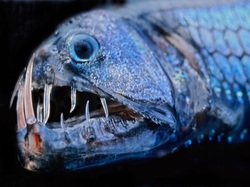"While you may not think about it, the deep sea has its own ecosystem with different plants and animals. The plants and animals that live in these cold environments, however, require special adaptations. Light does not fully penetrate to the sea floor, but these plants still undergo photosynthesis. They also produce oxygen. Deep sea plants provide food and shelter for the marine life living at these depths."- Misty Faucheux

'The deep-sea-warty octopus' - The deep-sea warty octopus lives in the depths of the deep sea. As you can see, this breed of octopus has white eyes and a pinkish skin color. Due to its white eyes, this warty octopus can't see, but uses its senses to navigate around the deep sea. This animal is very tiny - 5cm/ 2" - tall. It is one of the two octopus species found in 450 and 1500 metres deep.

'The juvenile King crab'- The juvenile King crab is a type of King crab that inhabits the deep sea. Because of its size and taste of its meat, it is eaten by humans. King crabs are sometimes called stone crabs because of its hard shell. King craba are told to come from hermit-crab ancestors. Speculations lead to this conclusion because of its hard shell. These crabs eat lots of plankton that inhabit the deep sea.

'The frilled shark'- Frilled sharks rarely have any encounters with humans because of their location in the sea. These creatures inhabit waters with 5,000 feet below the surface of the ocean. Scientists consider them living fossils because they contain many characteristics from the era of the dinosaur. This 5.3 foot specimen was once spotted in the shore near Japan in 2007, but died hours after being caught.

'Humboldt Squid'- The Humboldt Squid lives hundreds of feet below the surface. They occasionally come up to the surface and attack anything in view--including divers. The average size of this squid is four to five feet (one to two meters) long and 150 to 200 pounds but some behemoths can reach twelve feet, including its tentacles.

'Pacific viperfish'- The Pacific viperfish has needlelike teeth so huge it can't close its mouth. These deep-sea demons reach only about 8 inches long. They wander the depths up to 13,000 feet below, luring prey with bioluminescent photophores on their bellies.
